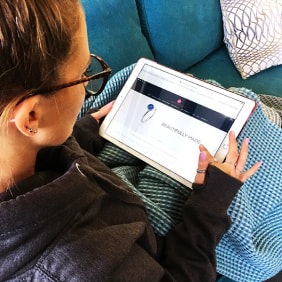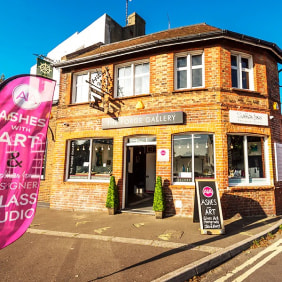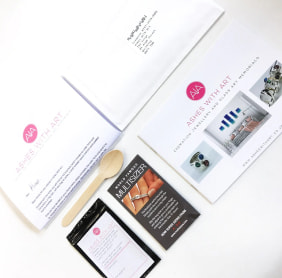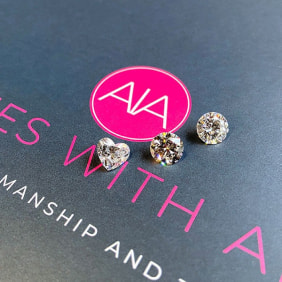Ring Sizing: Everything You Need to Know
When it comes to choosing an engagement ring, you might think that finding the right style within your budget is the biggest challenge. But before you make your final decision, you'll also need to know your partner’s ring size. And this isn’t something that everyone is aware of. So, how do you go about finding their ring size without arousing suspicion?
If you’re not sure of your partner's ring size, don’t worry. There are plenty of methods to help you find this information without their knowledge. But first, you need to get to grips with a few different things so you can be confident you’re making the right choices.
What is ring size?
Rings are made to fit different sizes, just like clothing and shoes. And since all of your fingers are different sizes, you could have a different ring size for each one.
Depending on where you are in the world, your ring size might be a letter code or it could be a number. In general, all ring sizes are measured in millimetres rather than centimetres.
In the UK, the ring sizing system uses letters and runs from A to Z+. The most common ring size for women is an M.
In the US, the ring sizing system uses numbers, and this runs from 3 to 13.5. Half sizes are available if you are between sizes. The average ring size for women is between 5 and 7.
In Europe, the ring sizing system also uses numbers, and these correspond to the inner circumference of the ring. The average size for women is between 49 and 54.
Most people assume that their ring size is similar to their shoe size, in that it remains the same over time, but this isn’t true. Small weight fluctuations can lead to changes in your ring size.
Many rings can be resized up or down, depending on your requirements, but this isn’t the case for all rings. Men’s rings, in particular, are more likely to be restricted when it comes to changing sizes. Men’s rings made from ceramic, titanium or platinum cannot be easily resized, so it’s vital to get the perfect fit from the start.
Women’s eternity rings and any ring with a pave stone setting on the band will also be unlikely to be able to be easily resized.
Now we understand the importance of ring sizing, we can look at the different ways to find out our ring size.
Finding your ring size
The simplest way to find out your ring size is by visiting a jeweller. They have ring sizing tools that will allow you to try on different ring sizes and find the one that works best for you. This is a great method, as it allows you to check that the ring also fits over your knuckle and not just over your finger.
You can also use a piece of string looped around the finger and then marked where the pieces cross. Measure the length of this string to get your ring circumference and then match this to the corresponding ring size.
However, this isn’t an option if you are buying for someone else and don’t want them to know. So, how do you find out someone’s ring size in secret?
The most popular method is to borrow and measure a ring you know they already wear. You can quickly measure the diameter of the inside of the ring and then return it. You can also print out a ring sizing sheet and use this to determine the best match for their ring size.
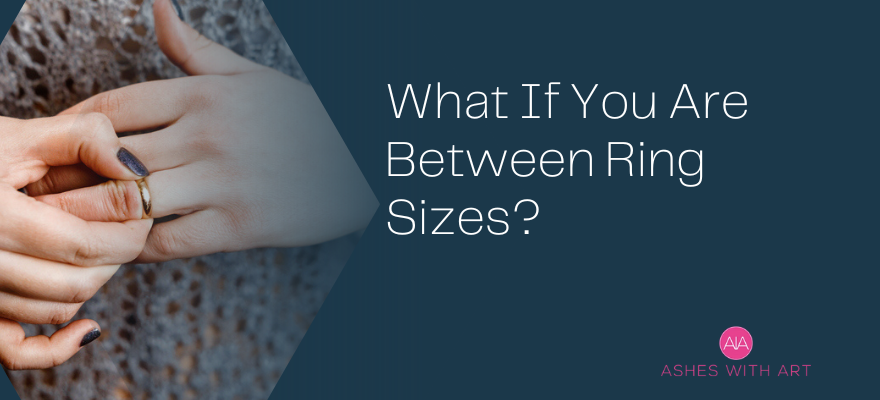
What if you are between ring sizes?
If you are between sizes, or if your ring size changes by a half size throughout the day, then you should always size up rather than down. It’s easier to make a too big ring smaller than it is to make a too small ring bigger. By sizing up, you’ll also account for hot days when your fingers will swell and this could make your ring uncomfortable if it is already snug.
The width of the band could make a difference as to whether or not it can be resized, so take this into consideration if you are between sizes or if you know that your weight might fluctuate.
Ring adjusters are small spirals of plastic that fit around the band of your ring. These can temporarily make a ring smaller, which is a great option if you don't want a permanent adjustment.
How do jewellers resize rings?
This very much depends on the type of ring and whether you need it to be larger or smaller. To make a ring larger, the jewellery needs to cut open the shank (the bottom of the ring) and add a metal bridge. This is soldered in place and the seam is often nearly invisible. This helps to maintain the thickness of the band. This method will often cost more as you will need to pay for the additional materials.
For incremental resizes, the jeweller could also place the ring on a ring mandrel and then gently hammer the piece to force it down the mandrel. This will cause the soft metal to gently expand. This is only suitable for certain ring materials, such as gold or silver. It is also a risky method for very ornate or decorative pieces, as there is no way to know where the ring will expand.
To make a ring smaller, the jeweller does the opposite. The shank is cut and then a small amount of the material is removed. The jeweller then solders the gap closed. The ring is then made into a round shape again, as the removed material can make it more oval shaped.
Can any ring be resized?
While the majority of rings can be resized, some rings are unsuitable for resizing, so you need to get the right size from the start. Most jewellers will only work with certain metals, such as silver, gold and platinum. This isn’t the only factor that will influence whether or not a jeweller will resize your ring.
- Metal type: Very hard materials, including tungsten, ceramic or titanium cannot be resized. On the other hand, materials like rose gold may be too delicate for resizing, as they are known to crack under pressure.
- Ring design: Certain rings are unsuitable for resizing because of the style of the ring. For example, if the band is very intricate, there may be no bare metal to work with, and resizing it would ruin the ring. Likewise, if the band has stones in the setting, resizing it will not work.
- Big changes. When resizing a ring, more jewellers will only be able to change it by one or two sizes. Larger changes can result in structural issues with the ring that damage the setting and cause stones to come loose.
However, while you might not be able to get a ring permanently resized, there are methods you can try to temporarily make a ring smaller. Ring adjusters are small plastic coils or clips that will fit behind your ring to make it feel smaller. While this isn’t a permanent fix, it can be useful to help prevent the ring from falling off your finger.
You can also wear a security ring on top of a ring that is too large. This is a discreet ring that is well-fitted to your finger and helps to prevent a too large ring from falling off.
Is it expensive to have a ring resized?
This depends on whether you are making the ring larger and smaller, and the amount of work required. Some jewellers will offer a free resizing service after a big purchase like an engagement ring. Others will offer a discount if you choose them to resize the ring, as they will be familiar with the construction.
The final cost of your ring resizing will depend on factors like the metal type, the stones, the setting and the band width. If resizing by just a few sizes, this will be a lot simpler than a more extensive resize. A simple resizing could cost as little as £30, with more complex jobs costing in the region of £100 to £150.
It makes sense to leave this job to the professionals, as they will be best placed to ensure that your ring is well preserved throughout the process. They will also be familiar with the materials and how to maintain the integrity of the ring so that you don’t lose stones further down the road.
Top tips for measuring your ring size
To avoid needing to resize your ring, getting the right measurement is essential. Here are some top tips for getting an accurate size:
- Measure a few times throughout the day to get an idea of how much your ring size changes throughout the day. You might find that your fingers are larger by the end of the day.
- If you are between sizes, go a ½ size up to help account for things like warm days and temporary swelling.
- Don’t assume that your ring size will never change. If you haven’t measured your ring finger for a while, remeasure before you make a big purchase.
